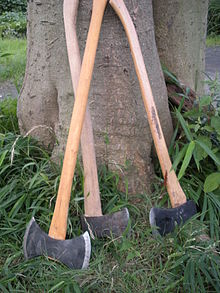This article includes a list of general references, but it lacks sufficient corresponding inline citations. (July 2016) |


An axe (/æks/; sometimes spelled ax in American English; see spelling differences) is an implement that has been used for millennia to shape, split, and cut wood, to harvest timber, as a weapon, and as a ceremonial or heraldic symbol. The axe has many forms and specialised uses but generally consists of an axe head with a handle, also called a haft or a helve.
Before the modern axe, the stone-age hand axe without a handle was used from 1.5 million years BP. Hafted axes (those with a handle) date only from 6,000 BC. The earliest examples of handled axes have heads of stone with some form of wooden handle attached (hafted) in a method to suit the available materials and use. Axes made of copper, bronze, iron and steel appeared as these technologies developed.
The axe is an example of a simple machine, as it is a type of wedge, or dual inclined plane. This reduces the effort needed by the wood chopper. It splits the wood into two parts by the pressure concentration at the blade. The handle of the axe also acts as a lever allowing the user to increase the force at the cutting edge—not using the full length of the handle is known as choking the axe. For fine chopping using a side axe this sometimes is a positive effect, but for felling with a double bitted axe it reduces efficiency.
Generally, cutting axes have a shallow wedge angle, whereas splitting axes have a deeper angle. Most axes are double bevelled (i.e. symmetrical about the axis of the blade), but some specialist broadaxes have a single bevel blade, and usually an offset handle that allows them to be used for finishing work without putting the user's knuckles at risk of injury. Less common today, they were once an integral part of a joiner and carpenter's tool kit, not just a tool for use in forestry. A tool of similar origin is the billhook.
Most modern axes have steel heads and wooden handles, typically hickory in the US and ash in Europe and Asia, although plastic or fibreglass handles are also common. Modern axes are specialised by use, size and form. Hafted axes with short handles designed for use with one hand are often called "hand axes" but the term "hand axe" refers to axes without handles as well. Hatchets tend to be small hafted axes often with a hammer on the back side (the poll). As an easy-to-make tool, the axe has frequently been used in combat, and is one of humanity's oldest weapons.[1]
- ^ "The history of the axe". Gränsfors Bruk Sweden. Archived from the original on 30 January 2023. Retrieved 30 January 2023.
